How to grow delicious salads all year round
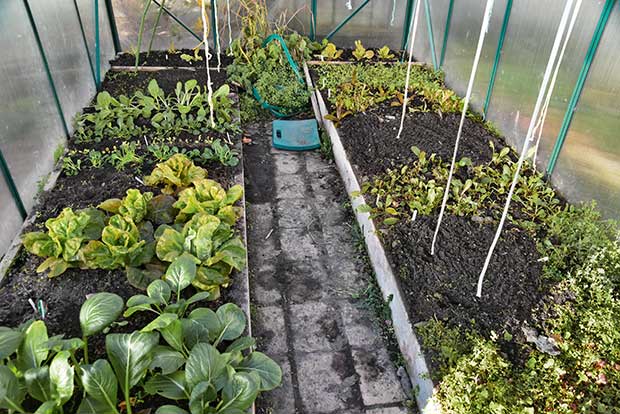
My greenhouse in a messy state in early spring showing sections of sowing and plantings.
Jenny shares her tips for a year-round lettuce supply and how to get more flavour into your greens.
Words and Images: Jenny Somervell
As a teenager growing up on a dairy farm, the vegetable garden was my domain. Fortuitously, it was just below the cowshed. I would watch my vegetables explode in growth overnight, copiously and inadvertently fertilised with the overflow of fresh, slushy cow manure from the holding yards. The lettuce in particular seemed to relish this deluge. Everyone was amazed at the head size. One variety called Webbs Wonderful was truly wonderful, with one plant enough to feed our family of nine.
It was the early 1970s and I grew the crisp head-types, which were the mainstay of salads and remain the market staple. Today the diversity of varieties available is immense, but only if you grow your own. Nothing beats the satisfaction of harvesting a colourful assortment of crisp, chemical-free leaves, dripping with dew, fresh from your own garden.
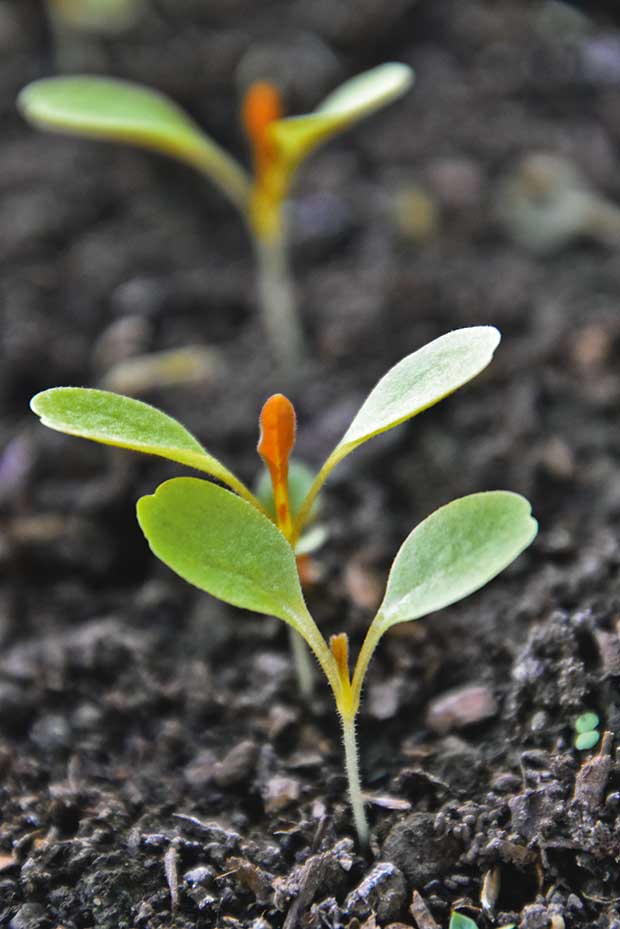
Red Oak lettuce seedlings.
THE SUPPLY CHALLENGE
The challenge is getting a continuous supply. The typical pattern is to have masses to give away one week and nothing to eat the next. It took the construction of a gale-proof greenhouse and three years of trial and error for us to get fresh greens year-round. I found the key is always having enough on the go so you can pick a varied selection of something.
Sowing little and often works best. For us that means sowing something every couple of weeks in spring, summer and autumn, and three to four weeks apart in winter to maintain a good supply. I’m a hibernating bear in winter, but even l can manage to walk out and sprinkle a few more seeds.
I always sow several varieties at once in different sites. This helps if I miss a sowing or we have any failures as lettuce seed is notoriously short-lived. It also extends the harvest as they mature at different times.
Transplanting the thinnings extends the harvest time further, as these mature later. We transplant the thinnings only when it is cool and cloudy, and often in the rain. Any surplus thinnings are eaten on the spot.
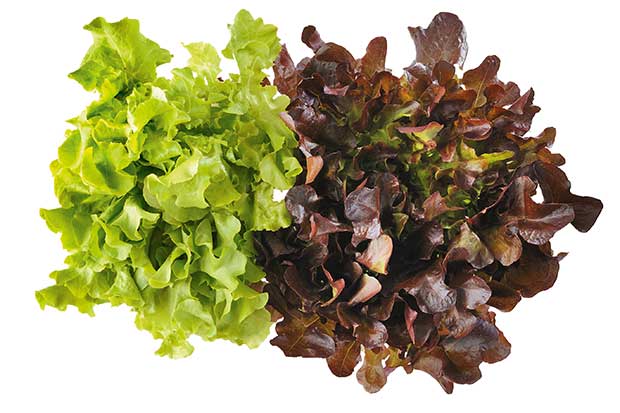
THE TEMPERATURE CHALLENGE
Lettuces prefer cooler summers where daytime temperatures rarely exceed 21-24°C which is a problem in our Canterbury climate. Too much heat only induces bolting, but worse, it also makes the leaves taste bitter. They grow well in full sun in spring and autumn, but do much better in shade in the summer months, and I also add compost and mulch around plants to keep them moist and cool.
Ideally a summer site would get morning or evening sun, but shade the rest of the day. A study on shade effects in Kansas showed lettuce grown under 40% shade cloth over summer grew larger and faster and produced higher yields and quality of leaf than unshaded lettuces. I grow between rows of sweet corn or climbing beans, or in raised beds under fruit trees, usually harvesting before they fully mature. As soon as autumn temperatures drop at night, I prepare the greenhouse, adding lots of compost, cultivating the soil to a fine tilth, and sectioning the greenhouse into squares.
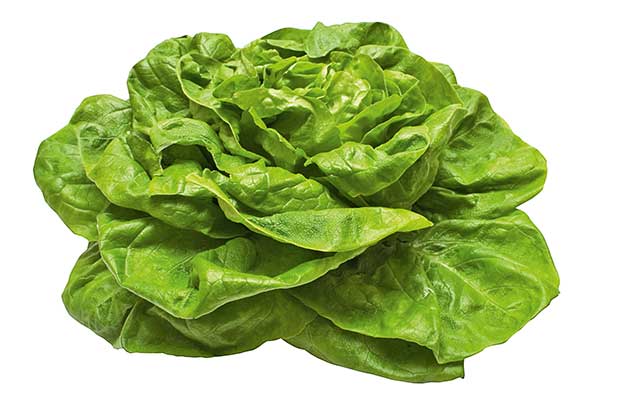
Then, in goes the first of a series of cut-and-come-again lettuces, both on their own and as part of a mesclun mix. Because lettuces grow more slowly in autumn, I sow up to one square a week for several weeks to give us a head start for winter cutting, the most productive use of our limited greenhouse space. When the first frosts arrive and outside lettuces become too bitter, we don’t need to rush to the supermarket. We simply switch to cutting the more succulent growth indoors.
All going well, we are still eating our greenhouse lettuces in August and September, just in time to start sowing for summer, although you can start sowing as soon as the ground is thawed and the soil is dry enough to rake. I start sowing from July, both in containers for transplanting outdoors and direct sowing under cloches. Hardy lettuces will tolerate -3°C frosts but even these do not like the sleet and snow we are prone to in early spring here in north Canterbury.
THE SECRET TO SUCCULENT LEAVES
The secret to meltingly succulent, sweet leaves (and this trick also stops plants from ‘bolting’) is to keep lettuces growing fast. Bitterness occurs in drought-stressed plants because it slows growth and signals the plant to produce more latex, a bitter, milky sap. Frank Stonaker, a researcher into lettuce bolting at Colorado State University, advises keeping soil consistently at a ‘moist sponge level’ – but never soggy – to ensure lettuces grow continuously to harvest. “Lettuce that wilts is much more likely to bolt and taste bitter.” Extra fertiliser during the growing season is generally not needed as it is likely to produce overly lush leaves which attract aphids and disease.
WHY THIS IS THE BEST LETTUCE YOU’LL EVER EAT
When harvest time comes – which, all going well, isn’t long – you will realise it was worth the effort. Before growing my own, I believed lettuce was a tasteless and limp plant, informed by my student years of eating four day-old, shop-bought produce. But eating home-grown lettuce is like eating new potatoes after the shrivelled remnants at the bottom of the post-winter potato sack.
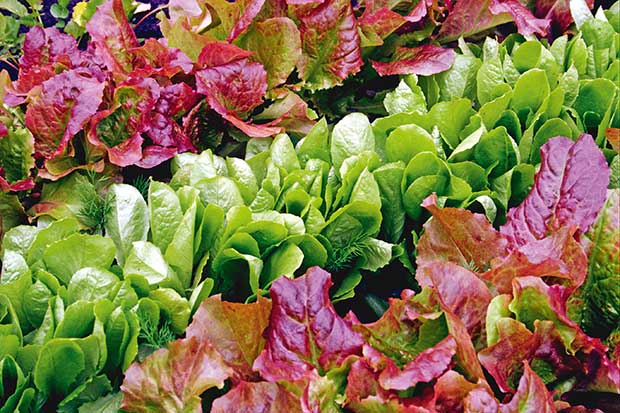
Home-grown lettuces are not hard to grow. They are attractive while growing, markedly superior in taste and nutritional value, and last much longer in the fridge on the rare occasions we hold them.
A few packets of seed will cost you less than a couple of lattes and at this time of year you don’t even need a greenhouse to get started. The best thing is you can delve into the wonderfully diverse and colourful varieties only available to the home gardener.
8 TIPS TO GROWING GREAT LETTUCE
Lettuces are surprisingly quick and easy to grow and take up very little space.
1. They will grow in most soils if given plenty of organic matter and good drainage.
2. Raised beds improve drainage and increase temperatures, helping with earlier crops.
3. Lettuces dislike acid soil, preferring a pH of 6.0-7.0.
4. Lettuces need a consistent supply of water and nutrients (regular moisture) but dislike waterlogging – water frequently and lightly for the sweetest tasting leaves.
5. Overhead water in the morning only, to allow leaves to dry off.
6. Avoid overwatering, which encourages root and leaf diseases.
7. Keep weed-free, but cultivate carefully with a shallow hoe as all lettuces have shallow root systems.
8. Lettuces prefer cooler summers. Choose summer varieties which are bolt-resistant such as Iceberg, Grenoble, Canasta, Great Lakes, and Black Seeded Simpson. Grow in part shade in hotter areas – I’ve had good success with shade-tolerant, leaf varieties such as Royal Oak.
13 TIPS FOR SOWING LETTUCES
Using space productively by sowing lettuce between Chinese cabbages.
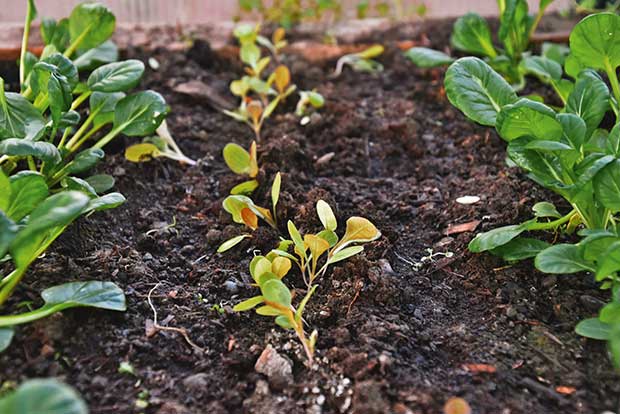
Using space productively by sowing lettuce between Chinese cabbages.
1. Seed is short-lived so use fresh seed.
2. Optimum germination is at 16-20°C.
3. Seed goes into dormancy over 26°C (thermo-dormancy) so keep seeds cool and shaded and avoid sowing in hot periods. Seeds will germinate at temperatures down to 10°C though emergence will be slower.
4. Lettuce seed is fine and most people sow too many – mixing seed with fine sand will help.
5. Barely cover – most varieties need light to germinate.
6. Press seeds into the moist soil. Keep the seedbed moist and shaded until seeds germinate, and expose to light gradually.
7. For direct-sown lettuces, thin to around 10cm for baby leaf and up to 30cm for hearting lettuce. Allow 20cm between rows.
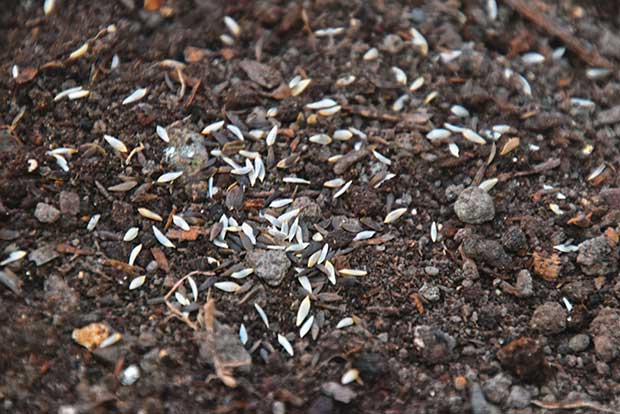
Sown lettuce seeds.
CONTAINER SOWING:
8. Use a good quality seed raising mix, and sow as for outdoors.
9. Prick out young seedlings into cavity trays as soon as they are large enough to handle but as small as possible to avoid transplant shock.
10. Gradually expose container-grown seedlings to full sunlight. They will be ready to harden off and plant out in about four weeks.
11. Water well over 24 hours and then one hour before transplanting to minimise shock.
12. Smaller plants will suffer less transplant shock.
13. Try to choose a cloudy day or evening, or cover with shadecloth. If plants are larger, cut off some of the larger leaves before transplanting.
Love this story? Subscribe now!
 This article first appeared in NZ Lifestyle Block Magazine.
This article first appeared in NZ Lifestyle Block Magazine.
